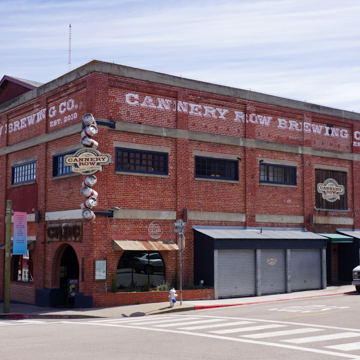You are here
Cannery Row Brewing Company
The Frank E. Booth Reduction Plant, on the southeast corner of Wave Street and Prescott Avenue, is a rare example of brick industrial architecture from the interwar period. Booth was an early pioneer in Monterey’s canning industry, opening a salmon canning factory on Alvarado Street in 1895. By 1905, his operation expanded to include sardine canning, and Booth retained the services of Knut Hovden, a Norwegian with a fisheries engineering degree, to help him mechanize the production process. In 1917, Booth further expanded his enterprise by constructing the three-story brick reduction plant, in which sardines were ground into fish meal for fertilizer. The building’s facade, facing Prescott Avenue, has large, arched window openings on the first story, decorative brick pilasters and belt courses, and a centralized false pediment atop a flat roof, making the building a highly decorative design that belies its industrial purpose.
Booth sold his business and its holdings to the Edgewater Packing Company in the 1940s. In 1946, the architect Robert R. Jones designed the wood-framed, stuccoed storage annex on the east side of Wave Street, abutting the reduction plant. Despite extensive renovations to adapt the building to commercial purposes, it remains the only wood-frame warehouse in the district. Furthermore, the two-story building is unique for its exterior second-story walkway on the facade. Since 2010, the plant has been home to the Cannery Row Brewing Company.
References
Architectural Resources Group. “Final Cannery Row Cultural Resources Survey Report Document.” Prepared for the City of Monterey, California, 2001.
Writing Credits
If SAH Archipedia has been useful to you, please consider supporting it.
SAH Archipedia tells the story of the United States through its buildings, landscapes, and cities. This freely available resource empowers the public with authoritative knowledge that deepens their understanding and appreciation of the built environment. But the Society of Architectural Historians, which created SAH Archipedia with University of Virginia Press, needs your support to maintain the high-caliber research, writing, photography, cartography, editing, design, and programming that make SAH Archipedia a trusted online resource available to all who value the history of place, heritage tourism, and learning.

















